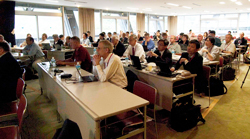 |
 |
|||||||||||||
|
|||||||||||||
|
|||||||||||||
|
One day before the beginning of the biggest ever – and first international – Particle Accelerator Conference, IPAC 2010, a satellite meeting was held with scientists and specialists from laboratories and industries around the world on the superconducting radiofrequency (SCRF) cavity technology and industrialisation. The meeting started with opening remarks made by Akira Yamamoto, one of the three Project Managers of the Global Design Effort. The morning session consisted of reports from laboratories. After the presentation about the current status of superconducting cavity development by Jim Kerby from Fermilab, two talks regarding the industrialisation experience in the European XFEL project (Olivier Napoly, CEA/Saclay) and the Large Hadron Collider (Philippe Lebrun, CERN) followed. Then, laboratory plans in the American and Asian regions were presented by Bob Kephart from Fermilab, and Hitoshi Hayano from KEK. In the afternoon sessions, representatives from industries and industrial forums in three regions gave talks. From Europe, Wolfgang Walter of Babcock Noell, a German company specialised in nuclear service, nuclear technology, magnet technology and environmental technology, talked about their experience in large international projects. The Americas region was represented by Tony Favale from the Advanced Energy Systems (AES), a leading commercial provider of high-brightness photocathode injectors and the first US supplier of superconducting accelerator components. “The GDE Director said that the ILC is a project and not a laboratory, and I would say that the ILC is a project and not a business,” said Favale. In his presentation, he made it clear that the industries around the world are facing the same problem. The number of components to be produced for ILC is bigger than for any other accelerator ever built. However, the numbers involved, such as 16,000 cavities, will not reach the stage of mass production. That number is many for the custom-order, but not enough to cover all the prior investments. If a company has no possibility to recover the investment on the machines, tools or R&D efforts, all those costs would be added directly onto the cavity cost. He thereby introduced a very important and difficult issue that the ILC community should address. Ken Olsen, President of the Superconducting Particle Accelerator Forum of the Americas (SPAFOA), gave a talk about the interim US market for superconducting radiofrequency (SCRF) accelerator technology. SPAFOA, formerly called the Linear Collider Forum of America (LCFOA) now expands the scope of the former LCFOA to include other major particle accelerator projects in addition to the ILC. Olsen defined the "US interim market" as demands of superconducting RF in the US from 2010 to 2015, and concluded that US industry can meet those demands. But they “are reluctant to invest in manufacturing plant and equipment based on risk.” From Asia, Eiji Kako from KEK summarised the industrialisation study done by KEK with Japanese industries. He presented the Japanese model for SCRF industrialisation: three cavities per day for five years. Based on the presentation, there started a debate between industries in the US, Europe and KEK scientists, about reasonable timeframe for cavity production. Following that, Akira Yamamoto introduced the activities of the Advanced Accelerator Association promoting Science and Technology (AAA) in Japan, in place of Michitaka Ono of Toshiba Co. Ltd. The last session of the meeting specialised in niobium. Hiroaki Umezawa from Tokyo Denkai Co. Ltd., a high-purity tantalum and niobium supplier in Japan explained the current niobium production situation saying: “We do not need to worry about the amount of niobium for the ILC,” but pointed out the following three items as "bottlenecks": refining, melting capacity, and sheet production process. Here again, the investment for the infrastructure was addressed. Following Umezawa, Bernd Spaniol from Heraeus, a German company specialised in precious metals and related technologies, talked about industrialisation of niobium, and proposed alternative production way to save the cost, cutting time and the amount of the material to be used. Yamamoto concluded the meeting saying: “I believe it has been a very useful workshop for us which showed us future scopes. I am very pleased I learned so much from this workshop.” The ILC community learned a lot, and at the same time they will bring back a lot of homework. -- Rika Takahashi |
|||||||||||||
| © International Linear Collider |

